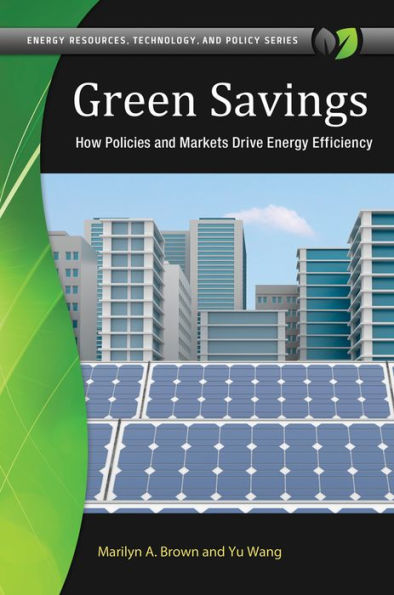Table of Contents
Figures, Tables, and Box ix
Series Foreword xiii
Acknowledgments xv
Chapter 1 Introduction 1
1.1 The Multiple Motivations for Energy Efficiency 4
1.2 The Value of Cross-Disciplinarity 6
1.3 The Energy-Efficiency Gap 6
1.4 The Focus on Electricity Consumption by "End-Users" 9
1.5 The Value of Polycentric Systems of Policies 10
1.6 International Trends, Challenges, and Opportunities 11
1.7 Questions and Challenges Addressed by This Book 14
1.8 Organization of This Book 14
Chapter 2 Energy-Efficient Technologies and Practices: Today's Portfolio and Tomorrow's Promise 17
2.1 How Energy and Electricity Are Currently Used 18
2.2 Technologies and Practices for Energy-Efficient Buildings 23
2.3 Technologies and Practices for Energy-Efficient Industry 28
2.4 Matching Load to Generation 33
2.5 Estimating the Levelized Cost of Electricity Generation and Savings 37
2.6 Energy Efficiency and Carbon Mitigation Supply Curves 42
2.7 Conclusions 44
Chapter 3 Obstacles to Energy Efficiency and the Logic of Policy Design 45
3.1 Market Failures and Public Interest Rationales for Public Policy 46
3.2 Market Failures and Barriers 50
3.2.1 Financial Barriers 51
3.2.2 Regulatory Barriers 54
3.2.3 Information Barriers and Behavioral "Wrinkles" 55
3.2.4 Lock-In of Energy Waste 58
3.3 Non-Energy Benefits, Costs, and Drivers 58
3.4 The Logic of Energy-Efficiency Policy Design 62
3.5 Conclusions 63
Chapter 4 Energy-Efficiency Policies and Programs in a Maturing Marketplace 65
4.1 A Taxonomy of Policy Instruments 66
4.2 Policy Levers for Energy-Efficient Buildings 71
4.2.1 Financing Policies 71
4.2.2 Regulatory Policies 78
4.2.3 Information Policies 86
4.3 Policy Levers for Energy-Efficient Industry 93
4.3.1 Financing Policies 93
4.3.2 Regulatory Policies 95
4.3.3 Information Policies 97
4.4 Integrating Policy Concepts 99
4.4.1 Economy-Wide Policy Instruments 100
4.4.2 Multiple Measures and Policies 105
4.4.3 Multiple Scales of Governance 107
4.4.4 Polycentric Governance 111
4.5 Conclusions 112
Chapter 5 Program Evaluation and the Need for New Business Models 115
5.1 Isolating the Efficiency Effect in Energy Intensity Metrics 116
5.2 Evaluating Energy-Efficiency Programs and Policies 118
5.3 Measurement and Verification of Impacts 119
5.4 Controlling for Rival Explanations 121
5.4.1 Free Ridership 123
5.4.2 Spillovers 124
5.4.3 Rebound 125
5.5 Trade-offs and Alternative Views of Success 126
5.6 Integrating Energy Efficiency into the Utility Business Model 129
5.6.1 Integrated Resource Planning 129
5.6.2 The Virtual Power Plant 130
5.6.3 Alternative Utility Models for Promoting Energy Efficiency 132
5.6.4 Third-Party Entities for Delivering Ratepayer-Funded Energy Efficiency 136
5.7 Conclusions 136
Chapter 6 Follow the Footprints: Leading and Lagging States 139
6.1 Federal Effort toward Energy Efficiency 140
6.1.1 Overview of National Legislation 141
6.1.2 Multiple Scale U.S. Governance of Energy Efficiency 142
6.2 State Performance on Energy Efficiency: A Statistical Analysis 143
6.2.1 Conceptual Framework for the Energy-Efficiency Performance of States 144
6.2.2 State Policies and Characteristics 146
6.2.3 Policy Impacts on State Energy-Efficiency Performance 148
6.3 Lessons from Leading and Improving States 152
6.3.1 Massachusetts 154
6.3.2 California 158
6.3.3 Wisconsin 163
6.3.4 Arkansas 166
6.4 Room for Improvement 169
6.5 Conclusions 173
Chapter 7 Potential for the Future 175
7.1 Technical, Economic, and Achievable Potential 177
7.2 Estimating the Potential with Energy Modeling 179
7.3 Policy Supply Curve for Energy Efficiency 182
7.4 Policy Supply Curve for Carbon Abatement 192
7.5 Comparison of Global Policy Practices 195
7.5.1 Germany 199
7.5.2 China 201
7.5.3 Japan 204
7.5.4 United Kingdom 207
7.6 Conclusions 210
Chapter 8 Policies and Markets: Moving Forward in Unison 211
8.1 The Skeptics and the Advocates 211
8.2 Policy Recommendations 213
8.2.1 Keeping Up with Technology Assets 214
8.2.2 Following the Leaders 215
8.2.3 Employing Polycentric Policy Systems 216
8.2.4 Closing the Energy-Efficiency Gap 217
8.3 Looking to the Future 217
Appendix: Correlation Table: All Variables 219
Notes 223
References 269
Index 273



